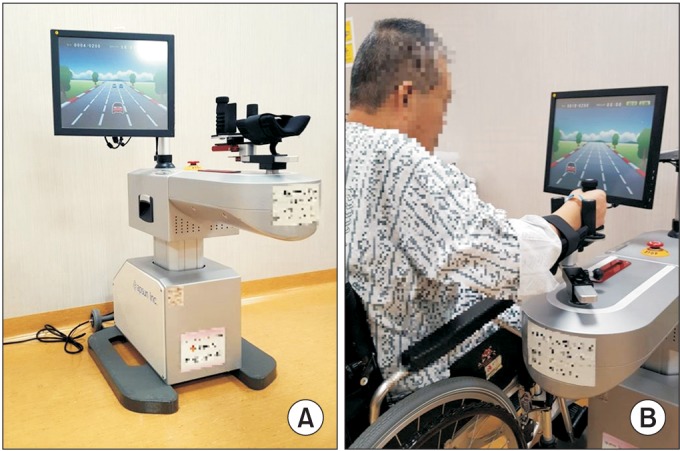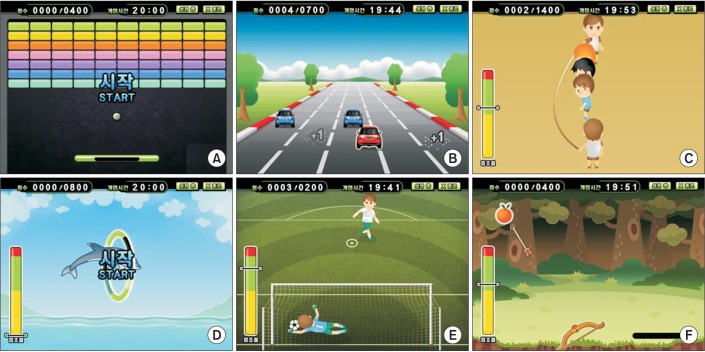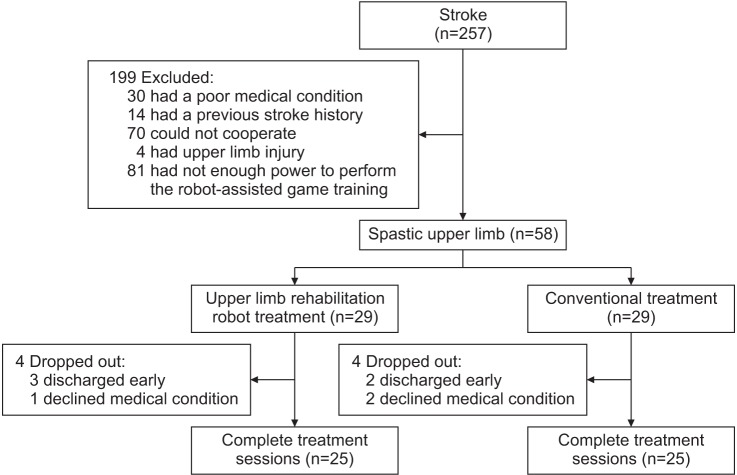Ann Rehabil Med.
2017 Aug;41(4):539-546. 10.5535/arm.2017.41.4.539.
Effect of Robot-Assisted Game Training on Upper Extremity Function in Stroke Patients
- Affiliations
-
- 1Department of Physical Medicine and Rehabilitation and Regional Cardiocerebrovascular Center, Dong-A University College of Medicine, Busan, Korea. tiyon@naver.com
- KMID: 2389398
- DOI: http://doi.org/10.5535/arm.2017.41.4.539
Abstract
OBJECTIVE
To determine the effects of combining robot-assisted game training with conventional upper extremity rehabilitation training (RCT) on motor and daily functions in comparison with conventional upper extremity rehabilitation training (OCT) in stroke patients.
METHODS
Subjects were eligible if they were able to perform the robot-assisted game training and were divided randomly into a RCT and an OCT group. The RCT group performed one daily session of 30 minutes of robot-assisted game training with a rehabilitation robot, plus one daily session of 30 minutes of conventional rehabilitation training, 5 days a week for 2 weeks. The OCT group performed two daily sessions of 30 minutes of conventional rehabilitation training. The effects of training were measured by a Manual Function Test (MFT), Manual Muscle Test (MMT), Korean version of the Modified Barthel Index (K-MBI) and a questionnaire about satisfaction with training. These measurements were taken before and after the 2-week training.
RESULTS
Both groups contained 25 subjects. After training, both groups showed significant improvements in motor and daily functions measured by MFT, MMT, and K-MBI compared to the baseline. Both groups demonstrated similar training effects, except motor power of wrist flexion. Patients in the RCT group were more satisfied than those in the OCT group.
CONCLUSION
There were no significant differences in changes in most of the motor and daily functions between the two types of training. However, patients in the RCT group were more satisfied than those in the OCT group. Therefore, RCT could be a useful upper extremity rehabilitation training method.
Keyword
Figure
Cited by 1 articles
-
Effects of Combined Upper Limb Robotic Therapy in Patients With Tetraplegic Spinal Cord Injury
Joo Hwan Jung, Hye Jin Lee, Duk Youn Cho, Jung-Eun Lim, Bum Suk Lee, Seung Hyun Kwon, Hae Young Kim, Su Jeong Lee
Ann Rehabil Med. 2019;43(4):445-457. doi: 10.5535/arm.2019.43.4.445.
Reference
-
1. Harvey RL, Roth EJ, Yu DT, Celnick P. Stroke syndromes. In : Braddon RL, editor. Physical medicine and rehabilitation. 4th ed. Philadelphia: Saunders;2011. p. 1178–1184.2. Stein J, Brandstater ME. Stroke rehabilitation. In : Frontera WR, DeLisa JA, Gans BM, Walsh NE, Robinson LR, editors. Physical medicine and rehabilitation: principles and practice. 5th ed. Philadelphia: Lippincott Williams & Wilkins;2010.3. Nichols-Larsen DS, Clark PC, Zeringue A, Greenspan A, Blanton S. Factors influencing stroke survivors’ quality of life during subacute recovery. Stroke. 2005; 36:1480–1484. PMID: 15947263.
Article4. Loureiro RC, Harwin WS, Nagai K, Johnson M. Advances in upper limb stroke rehabilitation: a technology push. Med Biol Eng Comput. 2011; 49:1103–1118. PMID: 21773806.
Article5. Prange GB, Jannink MJ, Groothuis-Oudshoorn CG, Hermens HJ, Ijzerman MJ. Systematic review of the effect of robot-aided therapy on recovery of the hemiparetic arm after stroke. J Rehabil Res Dev. 2006; 43:171–184. PMID: 16847784.
Article6. Masiero S, Carraro E, Ferraro C, Gallina P, Rossi A, Rosati G. Upper limb rehabilitation robotics after stroke: a perspective from the University of Padua, Italy. J Rehabil Med. 2009; 41:981–985. PMID: 19841828.
Article7. Sivan M, O’Connor RJ, Makower S, Levesley M, Bhakta B. Systematic review of outcome measures used in the evaluation of robot-assisted upper limb exercise in stroke. J Rehabil Med. 2011; 43:181–189. PMID: 21305232.
Article8. Chang YJ, Chen SF, Huang JD. A Kinect-based system for physical rehabilitation: a pilot study for young adults with motor disabilities. Res Dev Disabil. 2011; 32:2566–2570. PMID: 21784612.
Article9. Yong Joo L, Soon Yin T, Xu D, Thia E, Pei Fen C, Kuah CW, et al. A feasibility study using interactive commercial off-the-shelf computer gaming in upper limb rehabilitation in patients after stroke. J Rehabil Med. 2010; 42:437–441. PMID: 20544153.
Article10. Saposnik G, Teasell R, Mamdani M, Hall J, McIlroy W, Cheung D, et al. Effectiveness of virtual reality using Wii gaming technology in stroke rehabilitation: a pilot randomized clinical trial and proof of principle. Stroke. 2010; 41:1477–1484. PMID: 20508185.11. Mouawad MR, Doust CG, Max MD, McNulty PA. Wii-based movement therapy to promote improved upper extremity function post-stroke: a pilot study. J Rehabil Med. 2011; 43:527–533. PMID: 21533334.
Article12. Hurkmans HL, Ribbers GM, Streur-Kranenburg MF, Stam HJ, van den Berg-Emons RJ. Energy expenditure in chronic stroke patients playing Wii Sports: a pilot study. J Neuroeng Rehabil. 2011; 8:38. PMID: 21756315.
Article13. Yavuzer G, Senel A, Atay MB, Stam HJ. “Playstation eyetoy games” improve upper extremity-related motor functioning in subacute stroke: a randomized controlled clinical trial. Eur J Phys Rehabil Med. 2008; 44:237–244. PMID: 18469735.14. Sale P, Mazzoleni S, Lombardi V, Galafate D, Massimiani MP, Posteraro F, et al. Recovery of hand function with robot-assisted therapy in acute stroke patients: a randomized-controlled trial. Int J Rehabil Res. 2014; 37:236–242. PMID: 24769557.15. Fasoli SE, Krebs HI, Stein J, Frontera WR, Hogan N. Effects of robotic therapy on motor impairment and recovery in chronic stroke. Arch Phys Med Rehabil. 2003; 84:477–482. PMID: 12690583.
Article16. Masiero S, Armani M, Ferlini G, Rosati G, Rossi A. Randomized trial of a robotic assistive device for the upper extremity during early inpatient stroke rehabilitation. Neurorehabil Neural Repair. 2014; 28:377–386. PMID: 24316679.
Article17. Miyamoto S, Kondo T, Suzukamo Y, Michimata A, Izumi S. Reliability and validity of the Manual Function Test in patients with stroke. Am J Phys Med Rehabil. 2009; 88:247–255. PMID: 19106794.
Article18. Shah S, Vanclay F, Cooper B. Efficiency, effectiveness, and duration of stroke rehabilitation. Stroke. 1990; 21:241–246. PMID: 2305399.
Article19. Langhorne P, Pollock A. Stroke Unit Trialists' Collaboration. What are the components of effective stroke unit care? Age Ageing. 2002; 31:365–371. PMID: 12242199.
Article20. Chang WH, Kim YH. Robot-assisted Therapy in Stroke Rehabilitation. J Stroke. 2013; 15:174–181. PMID: 24396811.
Article21. Saposnik G, Levin M. Outcome Research Canada (SORCan) Working Group. Virtual reality in stroke rehabilitation: a meta-analysis and implications for clinicians. Stroke. 2011; 42:1380–1386. PMID: 21474804.22. Miltner WH, Bauder H, Sommer M, Dettmers C, Taub E. Effects of constraint-induced movement therapy on patients with chronic motor deficits after stroke: a replication. Stroke. 1999; 30:586–592. PMID: 10066856.23. Masiero S, Celia A, Rosati G, Armani M. Robotic-assisted rehabilitation of the upper limb after acute stroke. Arch Phys Med Rehabil. 2007; 88:142–149. PMID: 17270510.
Article24. Taveggia G, Borboni A, Salvi L, Mule C, Fogliaresi S, Villafane JH, et al. Efficacy of robot-assisted rehabilitation for the functional recovery of the upper limb in post-stroke patients: a randomized controlled study. Eur J Phys Rehabil Med. 2016; 52:767–773. PMID: 27406879.25. Mehrholz J, Hadrich A, Platz T, Kugler J, Pohl M. Electromechanical and robot-assisted arm training for improving generic activities of daily living, arm function, and arm muscle strength after stroke. Cochrane Database Syst Rev. 2012; CD006876. PMID: 22696362.
Article26. Kwakkel G, Kollen BJ, Krebs HI. Effects of robot-assisted therapy on upper limb recovery after stroke: a systematic review. Neurorehabil Neural Repair. 2008; 22:111–121. PMID: 17876068.
Article27. Oujamaa L, Relave I, Froger J, Mottet D, Pelissier JY. Rehabilitation of arm function after stroke. Literature review. Ann Phys Rehabil Med. 2009; 52:269–293. PMID: 19398398.
Article
- Full Text Links
- Actions
-
Cited
- CITED
-
- Close
- Share
- Similar articles
-
- A Review of Robot-Assisted Gait Training in Stroke Patients
- Effects of Robot-assisted Arm Training in Patients with Subacute Stroke
- Brain-machine Interface in Robot-assisted Neurorehabilitation for Patients with Stroke and Upper Extremity Weakness – the Therapeutic Turning Point
- Robot-assisted Therapy in Stroke Rehabilitation
- Clinical Outcomes of Robot-assisted Arm Rehabilitation in Stroke Patients




